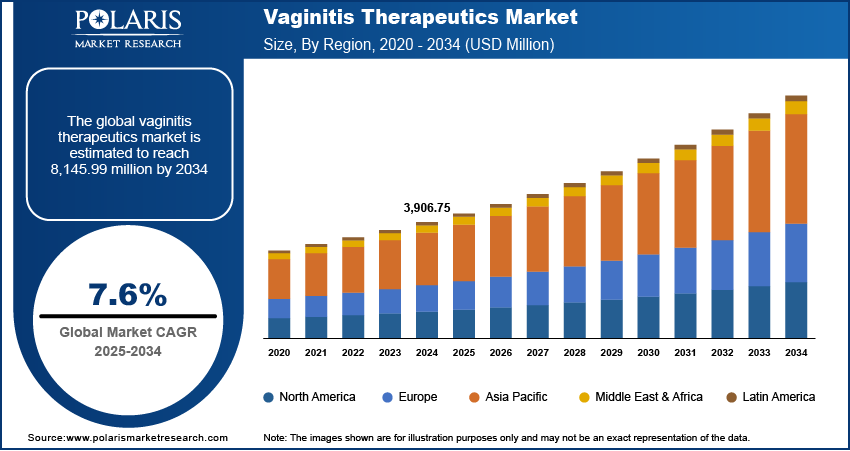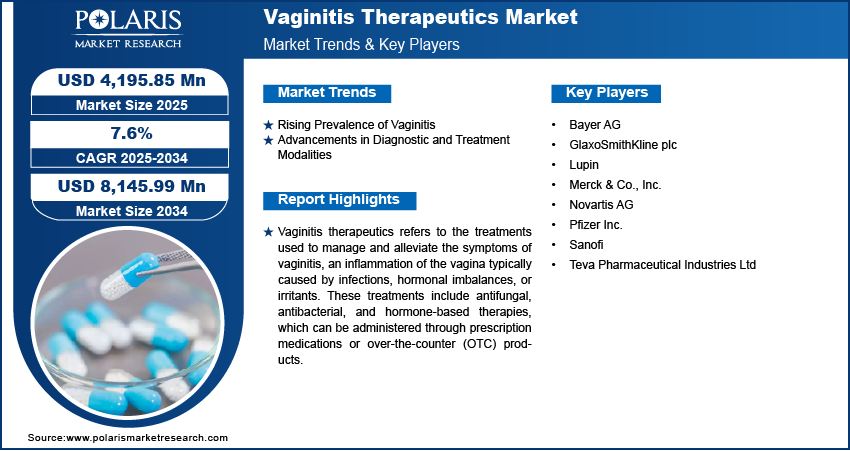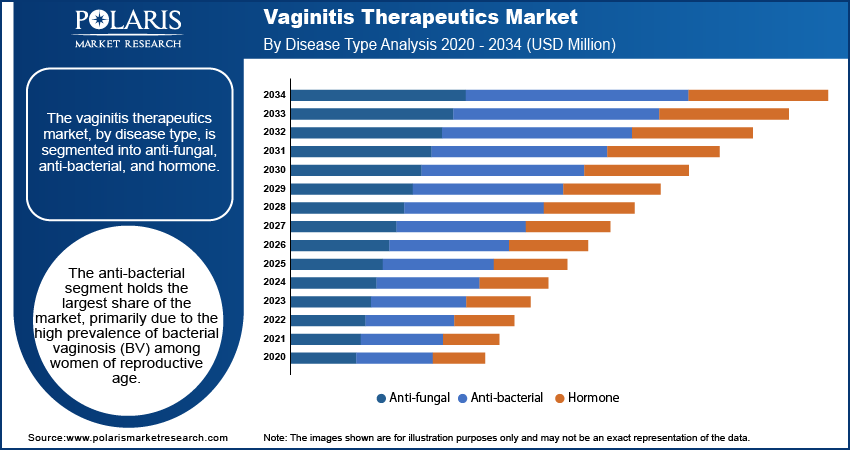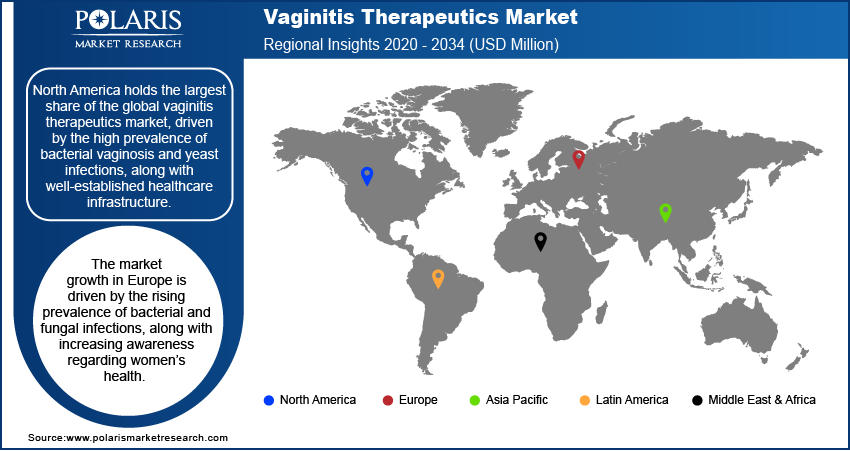
Vaginitis Therapeutics Market Size, Share, Trends, Industry Analysis Report
: By Disease Type (Anti-fungal, Anti-bacterial, and Hormone), Product, Distribution Channel, and Region (North America, Europe, Asia Pacific, Latin America, and Middle East & Africa) – Market Forecast, 2025–2034
- Published Date:Aug-2025
- Pages: 120
- Format: PDF
- Report ID: PM3987
- Base Year: 2024
- Historical Data: 2020-2023
Market Overview
The vaginitis therapeutics market size was valued at USD 3,906.75 million in 2024, growing at a CAGR of 7.6% during 2025–2034. The market growth is primarily driven by the increased incidence of bacterial vaginosis and the growing availability of innovative treatment formulations.
Key Insights
- The anti-bacterial segment accounts for the largest market share, owing to the high prevalence of bacterial vaginosis (BV) among women of reproductive age.
- The over-the-counter (OTC) segment is witnessing rapid growth. The segment’s growth is driven by the increased availability of FDA-approved OTC products for mild vaginitis.
- North America accounts for the largest market share. The high incidence of yeast infections and bacterial vaginosis fuels the demand for vaginitis therapeutics in the region.
- Asia Pacific is witnessing rapid growth. Rising awareness about vaginal infections and improving healthcare infrastructure contribute to the regional market growth.
Industry Dynamics
- The rising incidence of vaginitis, with bacterial vaginosis (BV) being the most prevalent form, is driving the demand for effective therapeutic interventions and fueling market growth.
- Advancements in treatment options and diagnostic techniques, such as pH measurement and improved laboratory testing, are influencing market development.
- Growing awareness of women’s health is expected to provide significant market opportunities in the coming years.
- Misdiagnosis and self-medication may hinder market growth.
Market Statistics
2024 Market Size: USD 3,906.75 million
2034 Projected Market Size: USD 8,145.99 million
CAGR (2025-2034): 7.6%
North America: Largest Market in 2024

To Understand More About this Research: Request a Free Sample Report
The vaginitis therapeutics market encompasses pharmaceutical and non-pharmaceutical treatments aimed at managing bacterial, fungal, and parasitic infections causing vaginal inflammation. The market includes antifungal agents, antibiotics, corticosteroids, and probiotics, along with over-the-counter solutions. The rising prevalence of vaginitis, driven by factors such as poor hygiene, increased antibiotic use, and hormonal changes, is contributing to market growth. Additionally, growing awareness of women’s health, advancements in diagnostic technologies, and an increasing preference for self-care products are fueling demand for effective therapeutic options.
Key drivers of the vaginitis therapeutics market growth include increasing cases of bacterial vaginosis and candidiasis, expansion of women’s healthcare programs, and rising availability of innovative treatment formulations. The growing adoption of probiotics for preventive healthcare and the development of combination therapies are also contributing to market growth. Furthermore, strategic collaborations between pharmaceutical companies and research institutions are accelerating the introduction of novel drug formulations.
Market Dynamics
Rising Prevalence of Vaginitis
The increasing incidence of vaginitis significantly propels the demand for effective therapeutic interventions. Bacterial vaginosis (BV), the most prevalent form, affects approximately 23% to 29% of women of reproductive age globally, as reported by the World Health Organization in 2024. Similarly, the National Center for Biotechnology Information (NCBI) indicates that yeast infections impact about 20% to 25% of women at least once in their lifetime. The high occurrence rates of these conditions underscore the necessity for accessible and effective vaginitis therapeutics, thereby driving the growth of the vaginitis therapeutics market demand.
Advancements in Diagnostic and Treatment Modalities
Advancement in diagnostic techniques and treatment options have influenced the vaginitis therapeutics market development. Enhanced diagnostic methods, such as improved laboratory testing and pH measurement, facilitate the accurate identification of vaginitis types, enabling targeted therapies. The precision in diagnosis allows healthcare providers to prescribe appropriate treatments, thereby improving patient outcomes and driving the market growth.

Segment Insights
Assessment – By Disease Type
The vaginitis therapeutics market segmentation, by disease type, is segmented into anti-fungal, anti-bacterial, and hormone. The anti-bacterial segment holds the largest share of the vaginitis therapeutics market revenue, primarily due to the high prevalence of bacterial vaginosis (BV) among women of reproductive age. BV is the most common vaginal infection, leading to a substantial demand for antibacterial treatments. The widespread occurrence of BV necessitates effective therapeutic interventions, thereby bolstering the prominence of the anti-bacterial segment in the market.
Evaluation – By Product
The vaginitis therapeutics market segmentation, by product, is segmented into over-the-counter (OTC) and prescription. The prescription segment dominates the vaginitis therapeutics market share, primarily due to the higher efficacy and safety profiles of prescribed medications. Healthcare professionals often recommend prescription drugs for severe or recurrent cases of vaginitis, as these treatments are tailored to address specific pathogens and patient needs. The availability of a wide range of prescription medications, including advanced antibiotics and antifungal agents, enables effective management of complex vaginitis cases, thereby driving the dominance of this segment in the global vaginitis therapeutics market.
The over-the-counter (OTC) segment is experiencing rapid growth, driven by the increasing availability of FDA-approved OTC products for mild vaginitis. The convenience and accessibility of OTC treatments empower women to manage common vaginal infections without a physician's consultation. This trend is further supported by rising awareness of women's health issues and a proactive approach to self-care, leading to a surge in demand for OTC vaginitis therapeutics. The expansion of product offerings in this segment caters to a broad spectrum of consumer preferences, contributing to its accelerated growth within the market.

Regional Insights
By region, the study provides vaginitis therapeutics market insights into North America, Europe, Asia Pacific, Latin America, and the Middle East & Africa. North America holds the largest share in the vaginitis therapeutics market revenue, driven by the high prevalence of bacterial vaginosis and yeast infections, along with well-established healthcare infrastructure. The region benefits from strong awareness regarding women’s health, widespread availability of advanced diagnostic tools, and the presence of major pharmaceutical companies investing in innovative treatment solutions. Additionally, the increasing adoption of over-the-counter (OTC) therapeutics and the availability of prescription medications further contribute to market dominance.
The Asia Pacific vaginitis therapeutics market is experiencing rapid growth due to improving healthcare infrastructure and rising awareness about vaginal infections. Increasing disposable income and greater accessibility to healthcare services are enabling more women to seek treatment for vaginitis, driving demand for both prescription and OTC products. Additionally, the region’s growing pharmaceutical industry and expansion of women's health initiatives are supporting vaginitis therapeutics market expansion in the region. The rising adoption of self-care solutions and increasing focus on personal hygiene further contribute to the market growth in Asia Pacific.

Key Players and Competitive Insights
The vaginitis therapeutics market features several prominent pharmaceutical companies actively engaged in developing and providing treatments for various forms of vaginitis. A few notable key players are Merck & Co., Inc.; Pfizer Inc.; Novartis AG; Teva Pharmaceutical Industries Ltd; Bayer AG; Lupin; GlaxoSmithKline plc; and Sanofi.
These companies contribute to the vaginitis therapeutics market by offering a diverse range of therapeutic options, including antifungal agents, antibiotics, and hormone-based treatments. Their extensive research and development efforts focus on introducing innovative and effective solutions to address the varying needs of patients suffering from vaginitis. Collaborations and partnerships among these organizations further enhance their capabilities to develop advanced treatments and expand their market presence.
The competitive landscape is characterized by continuous advancements in treatment modalities and a strong emphasis on improving patient outcomes. Companies are investing in clinical trials and exploring novel drug delivery systems to enhance the efficacy and convenience of their products. Additionally, strategic initiatives such as mergers and acquisitions, as well as geographic expansion, are employed to strengthen their positions in the global vaginitis therapeutics market.
Merck & Co., Inc., known as MSD outside the United States and Canada, is a global biopharmaceutical company dedicated to the discovery, development, manufacturing, and marketing of prescription medicines, biologic therapies, vaccines, and animal health products. The company's diverse portfolio addresses various therapeutic areas, including infectious diseases, oncology, and women's health. Merck's commitment to research and development has positioned it as a key player in the pharmaceutical industry.
Pfizer Inc. is a multinational pharmaceutical corporation that discovers, develops, manufactures, and commercializes biopharmaceuticals. Its product offerings encompass treatments for a wide range of conditions, such as cardiovascular diseases, oncology, inflammation, and rare diseases. Pfizer's extensive research efforts and strategic collaborations have solidified its presence in the global healthcare market.
List of Key Companies
- Bayer AG
- GlaxoSmithKline plc
- Lupin
- Merck & Co., Inc.
- Novartis AG
- Pfizer Inc.
- Sanofi
- Teva Pharmaceutical Industries Ltd
Vaginitis Therapeutics Industry Developments
- March 2023: BD (Becton, Dickinson and Company) obtained 510(k) clearance from the U.S. Food and Drug Administration (FDA) for the BD Vaginal Panel on the BD COR System. This diagnostic test is designed to directly detect the three most common infectious causes of vaginitis, utilizing BD's high-throughput molecular diagnostic platform for large laboratories.
Vaginitis Therapeutics Market Segmentation
By Disease Type Outlook (Revenue – USD million, 2020–2034)
- Anti-fungal
- Anti-bacterial
- Hormone
By Product Outlook (Revenue – USD million, 2020–2034)
- Over-the-counter (OTC)
- Prescription
By Distribution Channel Outlook (Revenue – USD million, 2020–2034)
- Hospital Pharmacies
- Retail Pharmacies
- Others
By Regional Outlook (Revenue – USD million, 2020–2034)
- North America
- US
- Canada
- Europe
- Germany
- France
- UK
- Italy
- Spain
- Netherlands
- Russia
- Rest f Europe
- Asia Pacific
- China
- Japan
- India
- Malaysia
- Suth Korea
- Indnesia
- Australia
- Vietnam
- Rest f Asia Pacific
- Middle East & Africa
- Saudi Arabia
- UAE
- Israel
- Suth Africa
- Rest f Middle East & Africa
- Latin America
- Mexic
- Brazil
- Argentina
- Rest f Latin America
Vaginitis Therapeutics Market Report Scope
|
Report Attributes |
Details |
|
Market Size Value in 2024 |
USD 3,906.75 million |
|
Market Size Value in 2025 |
USD 4,195.85 million |
|
Revenue Forecast by 2034 |
USD 8,145.99 million |
|
CAGR |
7.6% from 2025 to 2034 |
|
Base Year |
2024 |
|
Historical Data |
2020–2023 |
|
Forecast Period |
2025–2034 |
|
Quantitative Units |
Revenue in USD million and CAGR from 2025 to 2034 |
|
Report Coverage |
Revenue Forecast, Market Competitive Landscape, Growth Factors, and Industry Trends |
|
Segments Covered |
|
|
Regional Scope |
|
|
Competitive Landscape |
|
|
Report Format |
|
|
Customization |
Report customization as per your requirements with respect to countries, regions, and segmentation. |
FAQ's
The Vaginitis Therapeutics market size was valued at USD 3,906.75 million in 2024 and is projected to grow to USD 8,145.99 million by 2034.
The market is projected to register a CAGR of 7.6% during the forecast period.
North America held the largest share of the market in 2024.
A few notable key market players include Merck & Co., Inc.; Pfizer Inc.; Novartis AG; Teva Pharmaceutical Industries Ltd; Bayer AG; Lupin; GlaxoSmithKline plc; and Sanofi.
The prescription segment accounted for a larger share of the market in 2024.
The anti-bacterial segment accounted for the largest share of the market in 2024.
